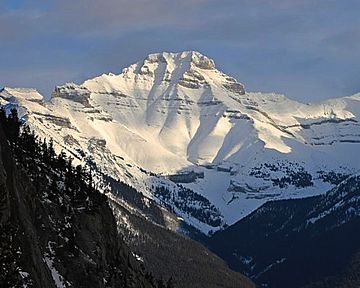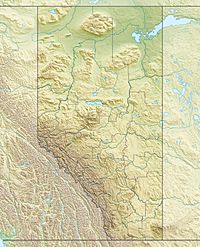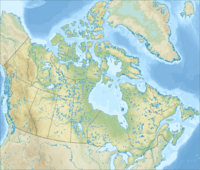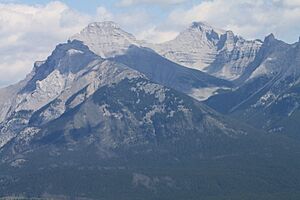Mount Inglismaldie facts for kids
Quick facts for kids Mount Inglismaldie |
|
|---|---|

Mount Inglismaldie in winter
|
|
| Highest point | |
| Elevation | 2,964 m (9,724 ft) |
| Prominence | 160 m (520 ft) |
| Geography | |
| Location | Alberta, Canada |
| Parent range | Fairholme Range Canadian Rockies |
| Topo map | NTS 82O/03 |
| Geology | |
| Age of rock | Cambrian |
| Type of rock | sedimentary rock |
| Climbing | |
| First ascent | 1933 |
| Easiest route | Scramble |
Mount Inglismaldie is a tall mountain in Banff National Park, Canada. It's the second highest peak in the Fairholme Range. You can find it just west of Mount Girouard, near the Bow River valley and south of Lake Minnewanka.
Contents
How Did Mount Inglismaldie Get Its Name?
The mountain got its name in 1886 from George A. Stewart. He was the superintendent of the park at that time. Stewart named it after Inglismaldie Castle, which is in Kincardineshire, Scotland.
Who First Climbed Mount Inglismaldie?
The very first time someone successfully climbed Mount Inglismaldie was in 1933. A group of people made the climb. This group included H. Foster, J. Packer, M.C. Wylie, Betts, Dickson, W. Innes, L. DeCouteur, J. Miskow, Sadler, and Vallance. They were guided by a famous climber named Lawrence Grassi.
What Is Mount Inglismaldie Made Of?
Like other mountains in Banff National Park, Mount Inglismaldie is made of sedimentary rock. This type of rock forms from layers of sand, mud, and tiny bits of plants and animals that settle over time.
How Old Are the Rocks?
The rocks in Mount Inglismaldie were formed a very long time ago. This happened during the Precambrian and Jurassic periods. These periods are part of Earth's ancient history.
How Did the Mountain Form?
The sedimentary rock layers were first laid down in shallow seas. Later, a huge event called the Laramide orogeny happened. This was a time when Earth's plates moved and pushed the rocks. The rocks were pushed east and stacked on top of younger rock layers, forming the mountain we see today.
What Is the Climate Like on Mount Inglismaldie?
Mount Inglismaldie has a subarctic climate. This means it has very cold and snowy winters. The summers are usually mild, not too hot.
How Cold Does It Get?
Temperatures on the mountain can drop below −20 degrees Celsius. With the wind chill, it can feel even colder, sometimes below −30 degrees Celsius.
Where Does the Water Go?
When snow melts or rain falls on Mount Inglismaldie, the water flows off the mountain. This water, called runoff, drains into Lake Minnewanka and the Bow River.




